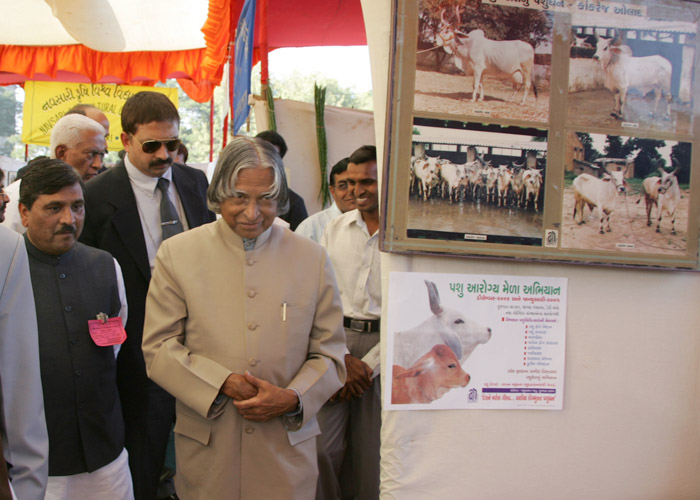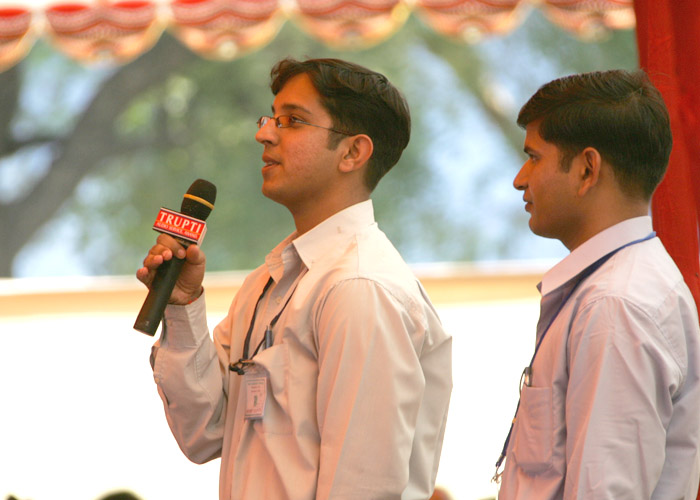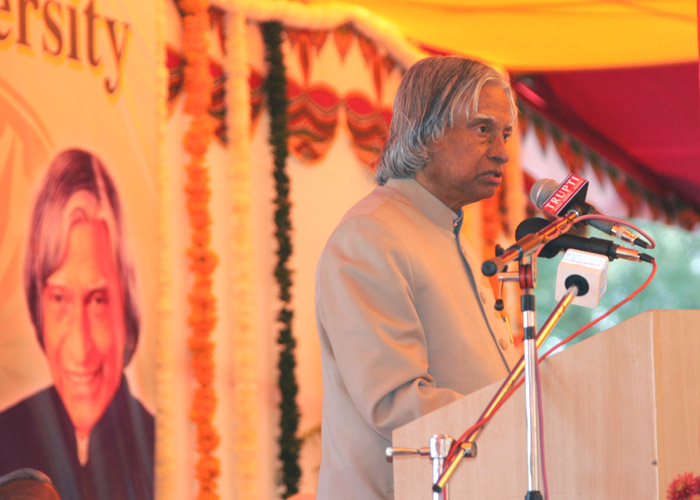|
|
ADDRESS AND INTERACTION WITH THE MEMBERS OF NATIONAL DIARY DEVELOPMENT BOARD, ANAND
14-12-2004 : Anand
PROFILE OF A COMPETITIVE INDIA
I am indeed delighted to be with you today and interact with the members of the National Dairy Development Board and the students of Anandalaya. My greetings to the Chairperson, NDDB and members of the Board, dairy scientists/technologists, administrators, staff and students.
I was thinking and thinking, what is the challenge before the nation today. I have visited all parts of our country and talked to the children, the youth and the experienced. I have also visited five countries in three continents. Particularly, I happened to address the Pan-African Parliament represented by 53 African countries. Here again I happened to meet the heads of state of these countries and the citizens. These meetings triggered many random thoughts in me. I would like to share with you, how the Father of our Nation Mahatma Gandhi working at Durban in South Africa experienced the insult and humiliation under the apartheid regime and fought back. This later on led to the birth of non-cooperation movement through non-violence. Then I recalled the connectivity with the Kalinga war scene around 2000 years back where Emperor Ashoka, while celebrating the victory in the Kalinga war, at the cost of the death of more than one hundred thousand people and equal number injured. In his victory, the emperor saw the blood bath in the moon lit night. Here we see the birth of Ahimsa Dharma, out of this tragic scene created by the Emperor himself and grow into a laudable philosophy that spread across the world.
Also, I would like to share with you, the scene in the Robben island of Atlantic Ocean. In this scene, I see an indomitable spirit of Dr. Nelson Mandela, who was jailed for 26 years in a single prison cell. When he was freed, he gave two great gifts to his nation. One is the magnanimity in victory by providing equal constitutional right to the 10% of the white population, who were the main propagators of apartheid. And also he gave his famous work which he wrote stealthily in the prison, the book entitled ? ?A long walk to freedom?. With all my experience in India and abroad, one thing is very clear, that in the planet of 6 billion people, what is needed is the fight against injustice. Mahatma Gandhi in Africa fought against apartheid, Dr. Nelson Mandela gave the final leadership to remove the apartheid regime from South Africa. In India, Gandhiji with his experience in fighting against injustice in South Africa fought against the British for India?s freedom. From these experiences, what we learn historically is that we have to have a major mission against injustice and we have to fight till injustice vanishes.
What is that injustice for India today? The injustice that we have to fight today according to me is the societal and economic impoverishment and inequality in various aspects of life for a large number of people. India?s movement in removing this impoverished state will become a trend setter for the whole planet as in the past. When India got the freedom in 1947, many nations in Asia and Africa were inspired to fight for freedom and realize freedom for their nations. Hence the overwhelming question which I would like to reflect today is that - when will India become a developed nation? ? And show the way to the other developing nations. Will history repeat itself?
Our National mission - challenges
Our nation is going through a major challenge of uplifting of 260 million people who are below the poverty line and also to give better life for many millions who are on the border line of poverty or just above the poverty line. They need decent habitat, they need work with reasonable income, they need food, they need health care, and they need education and finally resulting into a good life. Our GDP is growing at more than 6% per annum on an average. Whereas, the economists suggest that to uplift the people from below the poverty line, our economy has to grow at the rate of 10% per annum consistently, for over a decade.
Integrated action: To meet the need of one billion people, we have the mission of transforming India into a developed nation. We have identified five areas where India has a core competence for integrated action:
(1) Agriculture and food processing
(2) Reliable and Quality Electric power, Surface transport and Infrastructure for all parts of the country.
(3) Education and Healthcare
(4) Information and Communication Technology
(5) Strategic sectors.
These five areas are closely inter-related and if well done would lead to national, food, economic and security.
Engines for Growth: Emphasis should be on full utilization of natural and human resources of the nation to meet the demands of the modern society. We should also remember that about 50% of our population is young people with aspirations for better living. Value addition to Agriculture, Manufacturing and Service sectors, building the national core competence and technologies will lead to additional high income employment potential. The engines for growth will be accelerated by launching of the five national missions viz. water, energy, education and skills, infrastructure and employment generation that will enable achievement of 10% GDP growth rate per annum. It is possible to do so with ecological and economic sustainability.

With these aspects, we have already laid down the road map. The priority for the government is to convert the road map into various missions. While converting the vision into different missions we seem to have many thoughts and variety of routes to reach the goal. This is where there is a need to have a coherent thinking among all the members of the society. All of them need to think that the nation is greater than an individual or an organization. There is a mindset among many that ?we cannot do it?. However in my experience with many departments in the country and the observations of the results of some of them in the mission mode projects, I can assure you whenever we have decided to achieve certain goals with clear targets, we have always achieved it. I have seen this even in private and public sector industries - if they decide to take up tasks as a mission, they succeed. I would like to give some examples.

Our experiences in Mission mode
During 1960?s, I remember that India was in a state of ship to mouth existence in food. If the American ships did not bring wheat, there will be a famine in India. But there were two visionaries who worked together with the farming community and brought the first green revolution. They are the political thinker Shri. C. Subramaniam and the Agriculture scientist Dr. M.S. Swaminathan. Around the same time, Dr Varghese Kurien masterminded the white revolution. Today we produce two hundred million tonnes of food grains, which is not only sufficient for us but we can also export. Similarly, the white revolution resulted in placing India at the top of the world map of milk producers.
In India much innovation and creative thinking took place at various phases of our development. Dr. Vikram Sarabhai in 1960?s said that India should design and develop large satellite launch vehicle and put communication satellite and remote sensing satellite in geo-synchronous orbit and polar orbit respectively. This vision statement ignited hundreds of scientist, technologists and thousands of technicians. Today India is capable of building any type of satellite launch vehicles and satellites. Similarly the Vision of nuclear programme led to establishing series of nuclear power plants adding 3000 megawatt power to our electrical grid of 100,000 megawatt. There is a proposal to increase the nuclear power to 20,000 megawatt by 2020.
In the 80?s, India had a very low base in Information Technology. Some young entrepreneurs with their innovative and creative thoughts and within the difficult boundary conditions of India?s rules and regulations, demonstrated how IT enabled services can fetch export revenue. Subsequently, even Government had to bring out innovative and liberalized IT policies. Now, our young IT entrepreneurs are making export revenue of 15 billion dollars. This is expected to grow to more than 100 billion dollars by the year 2020. Similarly the Pharma industries are making a positive impact in the Indian economy. Our garment industry and our export of flowers and diamond are not far behind. Our auto-component and auto mobile industries have made remarkable breakthroughs. Our cement industry has great achievements in energy efficiency. Fly ash utilization which was just 3% in 1993 is now close to 25% after mission mode approach. It will further grow as fly ash has multiple applications.
These successful missions give us the confidence that as a country we have the resources and the capability to achieve challenging missions, if only we decide to achieve it.
My visualization of that competitive Developed India is the profile, which I would like to share with you today.

Profile of Competitive India
1. A Nation where the rural and urban divide has reduced to a thin line.
2. A Nation where there is an equitable distribution of energy and quality water.
3. A Nation where agriculture, industry and service sector work together in symphony, absorbing technology thereby resulting in sustained wealth generation leading to higher employment potential.
4. A Nation where education is not denied to any meritorious candidates because of societal or economic discrimination.
5. A Nation which is the best destination for the most talented scholars and scientists all over the world.
6. A Nation where the best of health care is available to all the billion population and the communicable diseases like AIDS/TB, water and vector borne diseases, Cardiac diseases and Cancer are extinct.
7. A Nation where the governance uses the best of the technologies to be responsive, transparent, easily accessible and simple in rules, thereby corruption free.
8. A Nation where poverty has been totally alleviated, illiteracy and crime against women are eradicated and the society is unalienated.
9. A Nation that is prosperous, healthy, secure, peaceful and happy.
10. A Nation that is one of the best places to live in, on the earth and brings smiles on a billion plus faces.
These are the ten dimensional transformations needed for competitive India and we have to work for.
Now I would like to discuss some of the major missions which are essential for transforming India into a developed nation they are: Providing Urban Amenities in Rural Areas (PURA) and Employment generation through entrepreneurship. Now these missions need not be driven only by a Government department as was done by Space and Atomic Energy. It can be done by a bright group of entrepreneurs, using modern business models.


Employment Generation through entrepreneurship
There has been substantial growth in our higher educational system and we are generating over 3 million graduates every year, and also after 10th class and Ten Plus Two nearly 7 million seek employment. However our employment generation system is not in a position to absorb the graduates passing out from the universities leading to increase in educated unemployed, year after year. There is a large mismatch between the skills required for the modern economy and the education imparted to most of these students. In addition, economic growth and investments have not kept pace with the availability of human resources. This situation will lead to instability in the social structure. We need higher education focused on and oriented towards high value and productive employment opportunities. A three pronged strategy is needed to make education more attractive, make it skill imparting and simultaneously create employment potential ? how do we do that?
Firstly, the educational system should highlight the importance of entrepreneurship and prepare the students right from the college education to get oriented towards setting up of the enterprises which will provide them creativity, freedom and ability to generate wealth. Diversity of skills and perseverance in work makes an entrepreneur. It should be taught to all the students. In addition, college syllabi even for arts, science, and commerce courses should include topics and practical where such entrepreneurship is possible. Secondly, the banking system should provide venture capital right from every village level to the prospective entrepreneurs for undertaking new enterprises. Banks have to be proactive to support the innovative products for enabling wealth generation by young entrepreneurs by setting aside the ?conventional tangible asset syndrome?. Definitely this involves certain amount of calculated risks, which can be eliminated by making an analysis of successful venture capital enterprises. Thirdly, there has to be an economic pull for human resources; for example generation of marketable products and enhancement of purchasing power among the people. This can come through the implementation of mega programmes such as PURA, Regional linking of Rivers, Infrastructural missions, Power missions and Tourism.
The educational institutions, Government and the private enterprises should become facilitators for creating this entrepreneurship scheme through the support of the banking system and the marketing system. This is one way of reducing the employment gap leading to upliftment of the 260 million people living below the poverty line and raising those who are just above the poverty line to raise much higher and have better standards of living.


Conclusion: Enlightened Citizenship
What is needed is the evolution of enlightened and visionary leaders amongst us in all walks of life whether it be politics, administration, religion, business, education or science which has a bearing on the evolution of our nation and the society. And, enlightened leadership is all about empowerment. When a child is empowered by the parents, he gets transformed into a responsible citizen. When a teacher is empowered with knowledge, a guru emerges. When women are empowered, a stable society gets established. When the political leaders of a nation empower the people through visionary policies, the prosperity of a nation is assured. When religions are empowered to become a spiritual force, peace and happiness blossoms in the society. It is thus, the need of the hour to develop enlightened leadership amongst various sections of our society who will have a vision and a commitment to peace, progress and development. When a leader of any institution empowers the people working with them, such leaders are created who can change the course of the nation itself. Empowerment by enlightened leaders will lead to the creation of enlightened citizens who have a strong value system. In short, my road map for national development has three components. Firstly we should inculcate education with a value system in our children, secondly ? ensure that religion graduates into a spiritual force and thirdly we should develop an enlightened leadership with visionary policies to lead the way towards national, global and economic prosperity.
I believe if the majority of the people become enlightened citizens, they will spread the righteousness in right earnest. If they do, I am very confident we will find the answers to ?When will India become a Developed Nation?? All the indications show that it will be before 2020. NDDB can definitely play its role by spreading its wings in different parts of the country and further diversifying its product range. I see a lot of young faces here who are keenly awaiting the results of our action of making India into a developed nation so that they can live in a happy, prosperous and peaceful country.
My best wishes to the NDDB community for success in their missions.
May God bless you.

<<Back
|
|